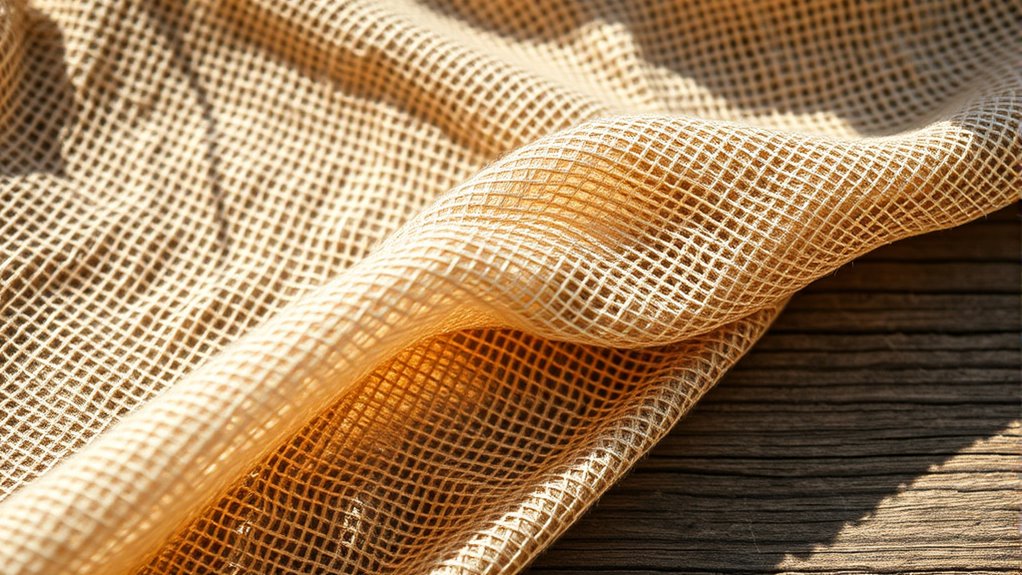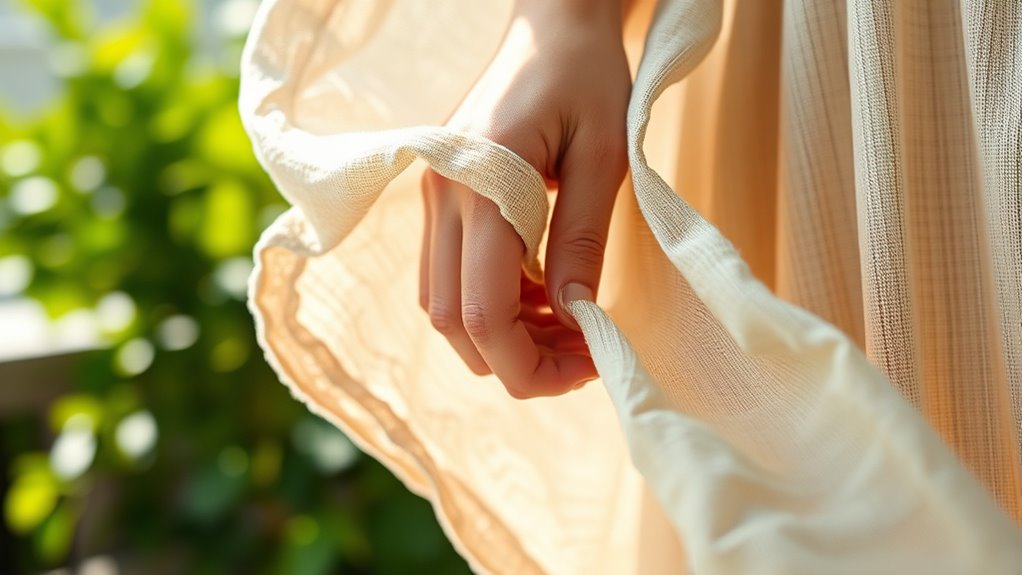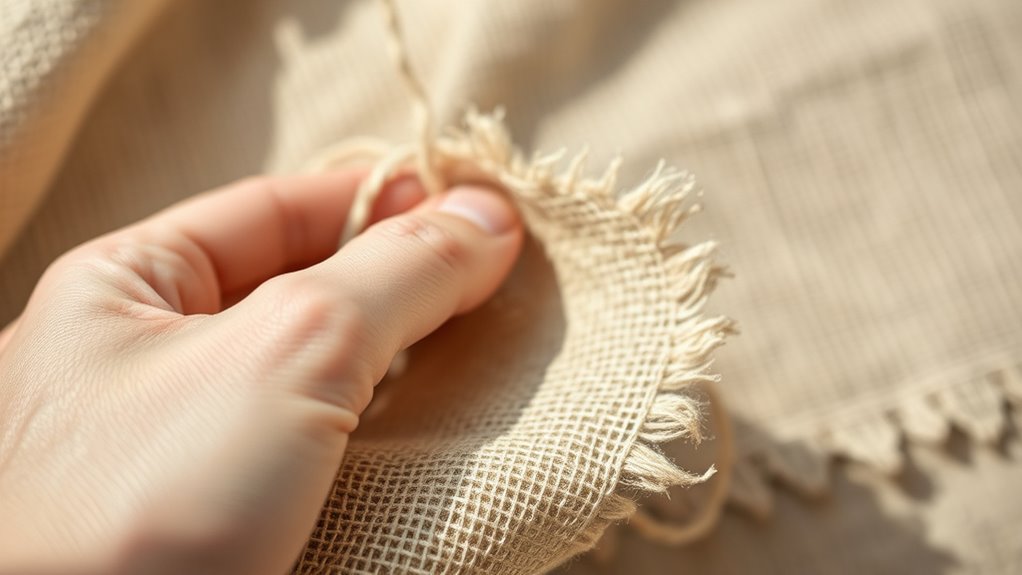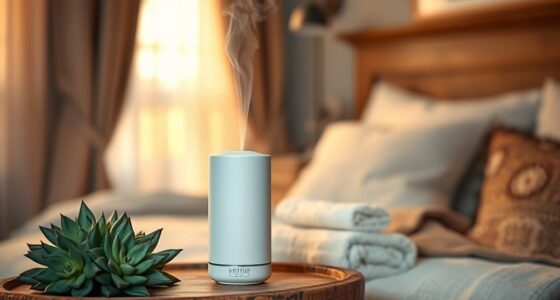Natural fiber textiles like cotton, linen, hemp, and bamboo offer excellent breathability and moisture management, making them ideal for daily comfort. They keep sweat away and allow air to flow, helping you stay dry and fresh all day. These eco-friendly fabrics are durable, soft, and easier to care for compared to synthetics. To discover more about how these fibers can enhance your wardrobe and wellbeing, keep exploring the benefits they provide.
Key Takeaways
- Natural fibers like cotton, linen, hemp, and bamboo provide superior breathability and moisture-wicking properties for daily comfort.
- Linen fibers promote rapid moisture absorption and airflow, keeping skin dry and cool in hot weather.
- Bamboo fabric efficiently pulls sweat away from the skin, enhancing airflow and preventing overheating.
- Natural fibers support eco-friendly production methods, reducing environmental impact and microplastic pollution.
- Proper care, such as gentle washing and storage, preserves the breathability and durability of natural fiber garments.
The Benefits of Natural Fibers in Daily Wear

Natural fibers like cotton, wool, and linen offer significant advantages for daily wear because they are breathable and moisture-wicking. These fibers are often produced through sustainable farming practices, reducing environmental impact and conserving resources. By choosing natural fibers, you support eco-friendly agriculture that minimizes chemical use and promotes soil health. Textile recycling also plays a role, allowing old garments made from natural fibers to be repurposed rather than discarded, which minimizes waste. This process keeps valuable materials in circulation and lessens reliance on synthetic options. When you opt for clothing made from natural fibers, you’re not only prioritizing comfort but also supporting sustainable farming and recycling initiatives that benefit the planet. Additionally, fire safety considerations in manufacturing and handling natural fibers ensure safe and responsible production practices.
Cotton: The Classic Breathable Choice

Cotton is a top choice when it comes to breathable fabrics because it absorbs moisture effectively, keeping you dry and comfortable. Its soft texture also guarantees gentle contact with your skin, making it ideal for sensitive skin types. With its natural properties, cotton helps you stay fresh throughout the day.
Superior Moisture Absorption
Because of its exceptional ability to absorb moisture, cotton remains a top choice for breathable fabrics. Its natural fibers wick away sweat, keeping you dry and comfortable. To maximize this benefit, consider these key points:
- Linen weaving techniques enhance cotton’s breathability, creating fabrics that efficiently manage moisture.
- Hemp dyeing methods produce vibrant, eco-friendly colors without compromising moisture absorption.
- Cotton’s porous structure allows it to hold moisture, preventing sweat buildup and reducing irritation.
- Combining cotton with other natural fibers like hemp can improve breathability and moisture management further.
- Incorporating positive thinking practices can enhance your overall comfort and well-being when wearing breathable textiles.
Gentle Skin Contact
Since sensitive skin can easily react to harsh fabrics, choosing clothing that feels gentle against your skin is essential. Cotton’s hypoallergenic properties make it an ideal choice for those with skin sensitivity. Its soft, natural fibers reduce irritation and help prevent allergic reactions, ensuring comfort all day. Cotton breathes well, wicks moisture, and remains gentle even after repeated washing. To better understand its benefits, consider this comparison:
| Fabric Type | Hypoallergenic | Breathability | Skin Sensitivity |
|---|---|---|---|
| Cotton | Yes | High | Suitable |
| Polyester | No | Low | Not ideal |
| Wool | Limited | Moderate | Can irritate |
| Silk | Yes | Moderate | Gentle |
| Nylon | No | Low | May cause irritation |
Cotton’s natural qualities make it the classic, breathable choice for gentle skin contact. Additionally, its moisture-wicking capability helps keep skin dry and prevent irritation.
Linen and Its Moisture-Wicking Properties

Linen is renowned for its exceptional moisture-wicking properties, making it an ideal fabric for breathable comfort. When you wear linen, you benefit from its natural ability to manage moisture efficiently through linen weaving techniques. Here’s why linen excels in moisture management:
- Its fibers quickly absorb sweat, pulling moisture away from your skin.
- Linen weaving creates tiny gaps, promoting airflow and evaporation.
- The fabric dries faster than many other fibers, keeping you cool.
- Its breathability reduces the risk of irritation and discomfort.
- Additionally, linen’s flexible fibers contribute to its ability to adapt and maintain optimal moisture control.
Thanks to these features, linen keeps you dry and comfortable even in hot, humid conditions. This moisture-wicking capability not only enhances comfort but also helps regulate body temperature, making linen a top choice for warm-weather clothing.
The Eco-Friendly Appeal of Hemp Textiles

Hemp textiles offer a compelling eco-friendly alternative to traditional fabrics like linen, thanks to their sustainable cultivation and minimal environmental impact. Hemp grows quickly, requires little water, and needs no synthetic fertilizers or pesticides, making it a highly sustainable crop. When you choose hemp, you’re supporting environmentally responsible farming practices that reduce soil erosion and lower carbon emissions. Additionally, hemp textiles are often dyed with eco friendly dyes, which avoid harmful chemicals, further reducing environmental harm. The natural durability of hemp means your clothing lasts longer, decreasing waste. By opting for hemp fabrics, you contribute to a greener future while enjoying breathable, natural fibers. Its eco-friendly appeal lies in both sustainable hemp cultivation and eco conscious dyeing processes, making it a smart choice for environmentally aware consumers. Furthermore, the low maintenance nature of hemp textiles adds to their appeal by requiring less energy for cleaning and care.
Bamboo Fabric: Softness and Sustainability Combined

Bamboo fabric stands out for its eco-friendly production methods that reduce chemical use and water consumption. Its silky soft texture offers a luxurious feel against your skin, while its moisture-wicking properties keep you dry and comfortable. Together, these qualities make bamboo a sustainable choice for breathable, everyday wear.
Eco-Friendly Production Methods
Because of its rapid growth and minimal resource requirements, bamboo has become a popular choice for eco-friendly textile production. To maximize sustainability, manufacturers use methods like:
- Applying organic dyes that reduce chemical runoff and lessen environmental impact.
- Implementing low impact weaving techniques that conserve water and energy.
- Utilizing mechanical processing instead of chemical-intensive methods to extract fibers.
- Choosing biodegradable finishes to ensure fabrics decompose naturally.
These approaches not only lower the ecological footprint but also produce textiles that are safe for both you and the environment. By focusing on sustainable practices, you get breathable, comfortable fabrics that align with eco-conscious values. Embracing these methods makes bamboo textiles a smart, responsible choice for stylish, environmentally friendly clothing.
Silky Soft Texture
Imagine running your fingers over a fabric that feels as smooth and luxurious as silk, yet remains eco-friendly and sustainable. Bamboo fabric offers a silky soft texture that instantly elevates your comfort. Its delicate touch caresses your skin, providing a luxurious feel without sacrificing sustainability. The fabric’s natural fibers create a gentle, breathable surface that’s perfect for sensitive skin. You’ll notice how effortlessly it drapes and feels lightweight, making it ideal for everyday wear. Despite its softness, bamboo fabric is durable and resilient, ensuring longevity while maintaining its silky quality wash after wash. Additionally, the fabric’s efficient manufacturing processes contribute to its environmentally friendly status, minimizing waste and energy consumption. This combination of silky softness and eco-conscious production makes bamboo fabric a top choice for those seeking both luxury and sustainability in their textiles.
Moisture-Wicking Capabilities
Have you ever wondered how to stay dry and comfortable during active moments or hot days? Bamboo fabric offers excellent moisture-wicking capabilities that help with dampness control and sweat management. Here’s how it works:
- It pulls sweat away from your skin quickly, reducing dampness.
- Its natural fibers facilitate rapid evaporation, keeping you cool.
- The fabric’s breathability boosts airflow, preventing overheating.
- Its moisture management properties minimize irritation caused by excess moisture.
- Its lightweight and flexible nature contribute to overall comfort and ease of movement. Breathability and comfort make bamboo fabric an excellent choice for activewear or everyday clothing, allowing you to focus on what matters without discomfort or distraction.
Comparing Natural Fibers: Comfort and Durability

When comparing natural fibers for breathable clothing, comfort and durability are key factors to weigh. Natural fibers like cotton, linen, and hemp often feel soft against your skin and improve with wear, offering lasting comfort. They generally require fewer chemical treatments than synthetic alternatives, which can sometimes rely on harsh chemical finishes to boost durability. Cotton is breathable and easy to care for but may weaken over time if not properly maintained. Linen and hemp are more durable, resisting wear and tear longer, though they can feel stiffer initially. While synthetic fibers might boast higher durability due to chemical treatments, they often sacrifice breathability and comfort. Natural fibers provide a balanced blend of comfort and durability without heavy reliance on chemicals, making them ideal for breathable clothing. Additionally, the airless paint sprayer technology highlights how modern tools can improve efficiency and finish quality, much like choosing the right natural fiber enhances garment performance.
Environmental Impact of Natural vs. Synthetic Textiles

Natural fibers like cotton, linen, and hemp are often praised for their comfort and durability, but their environmental impacts tell a different story. While they are biodegradable, their cultivation can require significant water, pesticides, and land use. Conversely, synthetic fabrics like polyester contribute heavily to synthetic fabric pollution, shedding microplastics into oceans every wash. Consider these points:
- Natural fibers biodegrade faster, reducing long-term waste.
- Cotton and hemp need less energy to produce compared to synthetic fibers.
- Synthetic fabric pollution results from microplastics released during washing.
- Manufacturing synthetic textiles often involves fossil fuels, increasing carbon emissions.
- The use of home decor materials like natural fibers can influence the overall sustainability of interior spaces.
Understanding these factors helps you see that natural fibers, despite some environmental costs, generally have a lower impact than synthetics, especially regarding long-term pollution and biodegradability.
Tips for Caring for Natural Fiber Garments

To keep your natural fiber garments looking their best and lasting longer, it’s important to follow proper care practices. Start by choosing the right detergent selection—opt for gentle, eco-friendly detergents specifically made for natural fibers to prevent damage and maintain softness. When washing, avoid harsh chemicals or bleach, which can weaken fibers. After washing, make sure to follow storage tips: fold your garments neatly and store them in a cool, dry place away from direct sunlight to prevent fading and deterioration. Avoid hanging heavy items for long periods, as this can cause stretching. Regularly airing your natural fiber pieces helps maintain freshness. Additionally, being mindful of laundry practices can significantly extend the life of your garments. By paying attention to these tips, you’ll preserve the breathability, texture, and longevity of your natural fiber garments.
Frequently Asked Questions
How Do Natural Fibers Perform in Extreme Weather Conditions?
In extreme weather, natural fibers like wool and cotton perform well by providing thermal insulation and moisture regulation. You’ll find wool keeps you warm in cold conditions by trapping heat, while cotton helps wick away sweat and keeps you dry in hot weather. These fibers adapt to changing temperatures, ensuring you stay comfortable. Their breathability helps prevent overheating or chilling, making them reliable choices for diverse and challenging climates.
Are Natural Fiber Textiles More Prone to Fading Over Time?
Like a portrait fading with time, natural fiber textiles can face colorfastness concerns, meaning they might be more prone to fading over time. While some natural fibers have better fading resistance, others are more vulnerable, especially with frequent washing or sun exposure. You should consider the fiber type and dye quality to guarantee your textiles maintain their vibrant look longer, making them a sustainable and attractive choice for your home or wardrobe.
Can Natural Fibers Be Blended for Improved Durability?
You can definitely blend natural fibers to improve durability through fiber blending. By combining fibers like cotton, wool, or silk with stronger materials, you enhance durability without sacrificing breathability. This method allows you to create textiles that resist wear and tear better while maintaining comfort. So, if you’re looking for longer-lasting fabrics, fiber blending is a smart solution for durability enhancement, ensuring your textiles stay in great shape over time.
What Are the Best Natural Fibers for Sensitive Skin?
If you have sensitive skin, you’ll want to choose hypoallergenic textiles that minimize irritation. Look for skin-friendly fabrics like organic cotton, bamboo, or silk, which are gentle and breathable. These natural fibers are less likely to cause allergic reactions or discomfort. By selecting these options, you guarantee your clothing feels soft and comfortable, helping you stay irritation-free and confident throughout the day.
How Do Natural Fibers Compare in Cost to Synthetic Alternatives?
Imagine weighing treasures in a balanced scale—cost comparison reveals that natural fibers often carry a higher price tag than synthetics. You’ll find natural fibers tend to be more expensive due to eco-friendly cultivation and processing, making affordability analysis essential. While synthetics may seem like the budget-friendly choice, natural fibers offer long-term benefits like breathability and comfort that could justify the initial investment in your wardrobe.
Conclusion
Choosing natural fiber textiles transforms your daily wardrobe into a powerhouse of breathability and comfort. Imagine wearing fabrics so airy and eco-friendly, they practically breathe with you—no sweat, no discomfort, just pure natural bliss. Switching to these fibers isn’t just a choice; it’s a revolution for your skin and the planet. Embrace natural textiles now and experience comfort so extraordinary, it’ll feel like you’re wearing a cloud, every single day.









